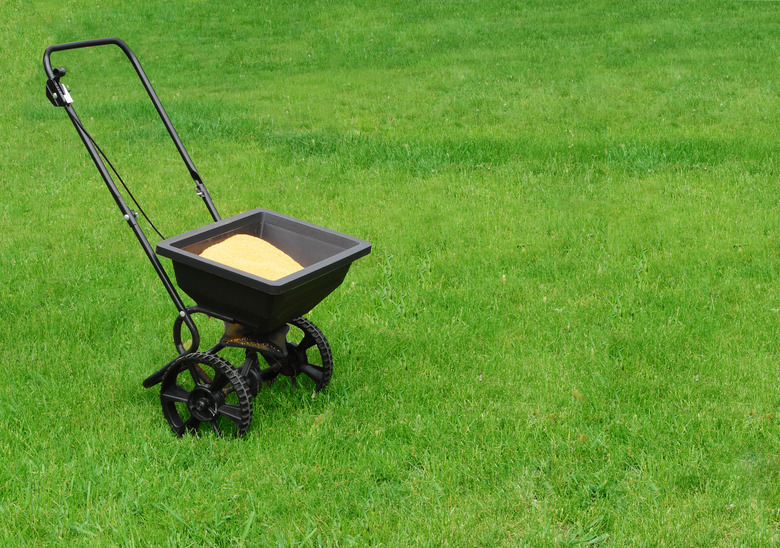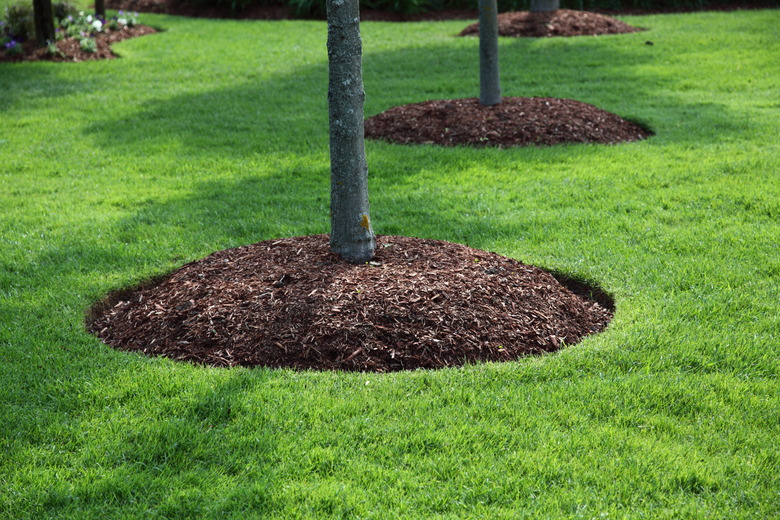How To Choose The Best Lawn Fertilizer Or Lawn Food
We may receive a commission on purchases made from links.
When they need a lawn fertilizer to perk up the front yard after a hard winter, some resourceful gardeners mix a can of beer with a cup of ammonia and a cup of non-antibacterial liquid soap, put it in the reservoir of a hose sprayer with a soap dispenser and give the grass a good watering. You might have never thought of beer and ammonia as plant food, but beer is full of nutrients that feed grass and helpful microbes in the soil, and ammonia supplies nitrogen, probably the most essential nutrient for grass.
Spraying beer on the grass may be fun, especially the morning after a party, and it doesn't hurt, but a beer-ammonia concoction isn't the best lawn fertilizer. If you want to find that, you first have to determine which nutrients the soil actually needs, and that starts with a soil test. You also have to decide whether you want results right away (and risk burning the grass) or if you're willing to wait a few weeks for results.
What Makes It a Fertilizer for Lawns?
What Makes It a Fertilizer for Lawns?
All plants need nutrients, including grass, and if you want greener grass, you have to supplement the nutrients the grass can't derive from the soil by itself. The three primary nutrients that plants need most are nitrogen (N) for green foliage, phosphorous (P) for strong roots and potassium (K) for overall health and resistance to disease. The NPK ratio of a commercial fertilizer, which is displayed on the container, denotes the relative concentration of these three essential elements in the mixture. A 10-10-10 fertilizer, for example, contains 10 percent nitrogen, 10 percent phosphorous and 10 percent potassium.
The most important characteristic of grass is its green color, so lawn fertilizers are typically high in nitrogen, and they often contain little to no phosphorous given that grass seldom needs extra phosphorous, and phosphates are far from eco-friendly. Pennington Ultragreen Lawn Fertilizer, for example, has an NPK ratio of 30-0-4, and 10 percent of the nitrogen is in a slow-release form. Scotts Turf Builder, with a 32-0-4 ratio, has an even higher concentration of nitrogen, which usually means you need less of it to meet the lawn's nitrogen requirements.
Nitrogen in a lawn fertilizer may be in a slow-release or quick-release form. Quick-release formulations are less expensive and produce green coloration quicker, while slow-release formulations are less likely to burn the grass and create a more uniform lawn. High-nitrogen concentrations aren't always desirable; they make lush grass types such as Kentucky bluegrass, Bermudagrass and centipede grass grow so fast and become so dense that the blades quickly become blocked with thatch.
Winter formulations designed to be applied in the fall often contain reduced amounts of nitrogen and more potassium and phosphorous. For example, in early spring, a 20-5-10 mixture generally gives the grass all it needs to recover from a freezing winter.
Choosing Your NPK Number
Choosing Your NPK Number
If you want to give your lawn exactly what it needs, you have to know what's available in the soil and what's missing, and that calls for a soil test. You can conduct this test yourself with a kit you can buy at a garden center or online, but if you want the most accurate results, you should take a soil sample to your local garden center or university extension service and have it tested in a lab. The advantage of lab testing is that you can also get recommendations for soil amendments for a healthy lawn.
If you find the soil to be deficient in nitrogen, you'll want to use a high-nitrogen mixture, and you now have to choose between applying a liquid or granular formulation. Liquid fertilizers make nutrients available quickly, but they leach out of the soil more quickly and need more frequent replenishment. They also have more potential for environmental contamination. If the soil isn't deficient in nitrogen, a more balanced mixture, such as an 18-6-12 formulation, will produce a healthier lawn overall than would a high-nitrogen mixture.
The soil test also tells you the soil pH, which is an important parameter. Grass can't utilize the nutrients in the soil if the pH is too high or too low. Grass generally thrives when the pH is between 6.0 and 7.0, and if the test indicates acidic soil with a pH lower than that, an application of lime may be in order. Suspect acidic soil if the grass seems to be suffering while weeds are thriving.
Organic vs. Synthetic Fertilizers
Organic vs. Synthetic Fertilizers
Both organic and synthetic fertilizers are readily available, and both are reliable NPK sources, but there's a difference in how they function as lawn food. Synthetic fertilizers tend to be water soluble, and while they feed the grass, they don't do anything for the soil, and much of what you apply tends to run off, which can be an environmental concern. They produce quick results, but you have to keep reapplying them throughout the growing season to keep the lawn fed.
An organic nitrogen fertilizer is made from products found in nature, such as cottonseed meal; bat, chicken or cow manure; fish emulsion; and blood meal. When properly applied, an organic fertilizer nourishes the soil and not just the grass, so its effects are longer lasting, but the downside is that weeds get nourished as well as the grass.
The best lawn fertilizer is probably a hybrid, such as Milorganite, a 6-4-0 formulation derived from processed waste that is 85 percent organic matter, or Scotts Turf Builder, a weed and feed formulation designed to help the lawn develop deep roots for the winter while controlling weeds with a pre-emergent weed killer. A good hybrid is a total lawn-care package, building up the soil while providing immediate nourishment to the grass and preventing weeds from growing.
The Best Fertilizer by Type of Grass
The Best Fertilizer by Type of Grass
You fertilize because you want a green lawn, but nourishing the roots is just as important, and some need extra help because they grow deep. For example, tall fescue, one of the cool-season grasses, has some roots that reach 2 to 3 feet deep, and they help make this grass hardy and drought tolerant. The roots of perennial ryegrass, another cool-season grass, also grow up to 2 feet deep, and unless soil tests indicate an overabundance of phosphorous, both of these grasses need a fertilizer that supplies phosphorous, such as Milorganite, to encourage root growth, especially during the spring growth spurt.
The roots of some warm-season grasses can grow even deeper. Bermudagrass has the deepest-growing roots of any grass species, some of which may reach 6 to 8 feet into the soil, depending on the soil profile, which gives it the ability to survive cold winters in the transition zone. Any fertilizing done from January to April, when the grass is burnt back from frost, should be based on soil tests to nourish the roots and should not contain nitrogen.
Nitrogen fertilization should be done only in the summer months when the grass is green, and it should be discontinued in the fall. The fertilizer should contain phosphorous only if soil tests indicate phosphorous deficiency in the soil. An application of a product such as Pennington Ultragreen in late spring should guarantee green grass throughout the summer.
Grasses with more shallow roots, like cool-season varieties Kentucky bluegrass and bentgrass and warm-season strains such as zoysia and centipede grass, benefit more from a light fertilizing with a high-nitrogen mix. They tend to be less hardy and need regular mowing and some limitation on foot traffic to maintain healthy root growth and greening.
Tips for Spreading Lawn Fertilizer
Tips for Spreading Lawn Fertilizer
Lawn fertilizer isn't exactly the same thing as lawn food. Grass, as all plants, manufactures its own food in the form of carbohydrates through the photosynthetic process, and the roots store these carbohydrates to maintain growth, sustain perennial plants during dormancy, and facilitate new growth of perennials in Spring. Soil fertility is important for providing nutrients including minerals that plant roots absorb and uptake for transport throughout the plant.
Fertilizer provides nutrients that are lacking in poor soil. Nitrogen is the most important of these because it tends to leach out of the soil and must be replenished more often than phosphorous or potassium. As a general rule, a typical lawn needs 1 pound of nitrogen per 1,000 square feet every time you fertilize in the summer.
The NPK ratio tells you the concentration of nitrogen in the product, and if you know the weight of the bag, which you do because it's listed on the label, you can calculate how much to spread. If a product has a low nitrogen concentration, you'll need to set your spreader to distribute more of it than you would if the product had a higher concentration. When using a quick-release formula, it's especially important to calculate the coverage to avoid applying too much nitrogen and burning the grass.
When you spread a granular fertilizer, it doesn't become available in the soil until it gets wet, so the ideal time to fertilize is just before a heavy rain. In arid places where summer rains are rare, plan on deep watering the grass immediately after fertilizing or using a liquid fertilizer. Keep in mind, though, that liquid fertilizers tend to pass through the soil more quickly than granular or water-soluble ones.
Grass Clippings as Fertilizer
Grass Clippings as Fertilizer
Grass clippings and dry leaves are some of the best lawn fertilizers, and they are also the easiest to apply. The clippings themselves are full of nitrogen, and when you spread dried leaves on the grass (or just don't rake them away), they help break the clippings down more quickly while acting as a good source of carbon and micronutrients for the lawn. It's important not to leave deep layers of large leaves on your grass, because they can become matted and impede the flow of rainfall to the grass while also hindering photosynthesis. Chop up fallen leaves by using a mulching mower before leaving them on your lawn.
Contrary to what you might have heard, grass clippings do not contribute to thatch as long as you mow frequently. Thatch is caused by a combination of compacted soil, too-vigorous growth resulting from excessive nitrogen fertilization and infrequent mowing. If you allow the grass to get too long, then the clippings can smother the lawn and should be removed, but if you mow regularly, the shredded leaves and grass clippings decompose easily and become lawn fertilizer.
It isn't always a good idea to leave clippings on the lawn after you mow. If the grass is infected by a disease such as rust, leaf spot or dollar spot, it's important to rake up the clippings and dispose of them to reduce the severity of the disease. Similarly, you should rake up clippings or collect them in your mower bag if you mow the lawn when it's wet because wet clippings can form a barrier on the top of the lawn and smother the grass.
When you collect grass clippings, don't just throw them away because they can impact water quality if allowed to wash into storm drains, and they are a valuable garden asset. If you don't use them on the lawn, use them as mulch elsewhere in the garden or put them on the compost pile.
References
- University of Illinois Extension: Choosing Fertilizers for Home Lawns
- Clemson Cooperative Extension: Bermudagrass Yearly Maintenance Program
- University of Minnesota Extension: What to Do with Lawn Clippings
- Popular Mechanics: The Quick and Easy Guide to Fertilizing Your Lawn
- Schill Grounds Management: Organic Vs. Synthetic — What Is The Best Fertilizer For Grass?


